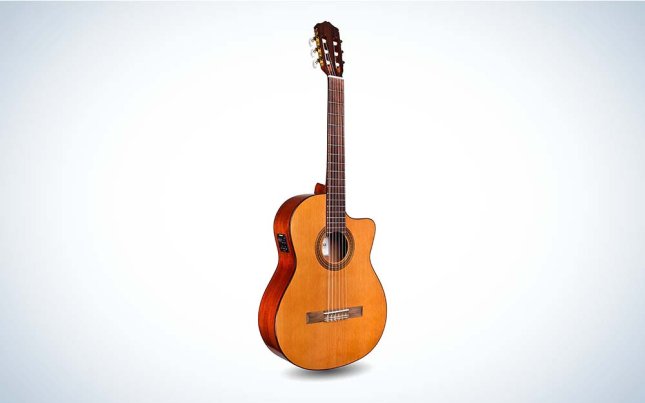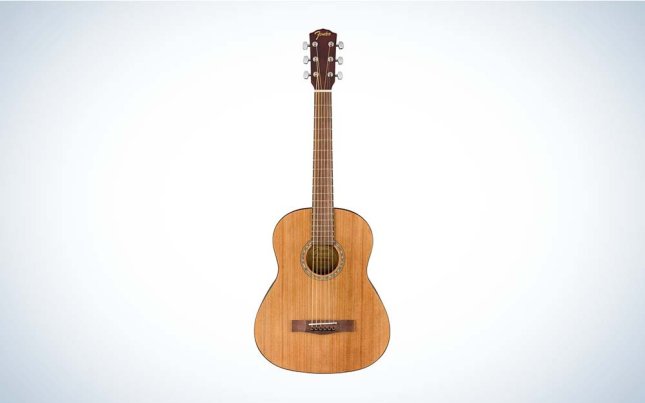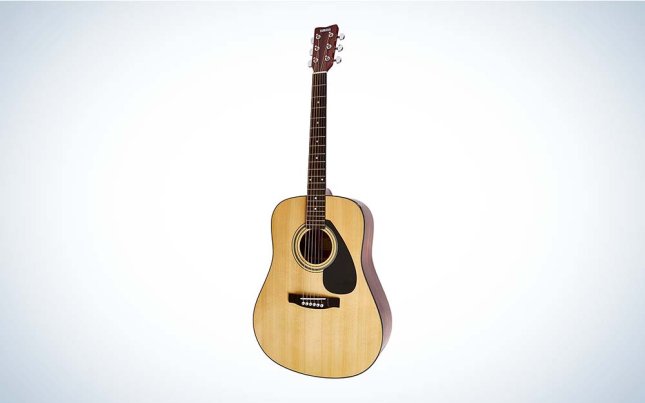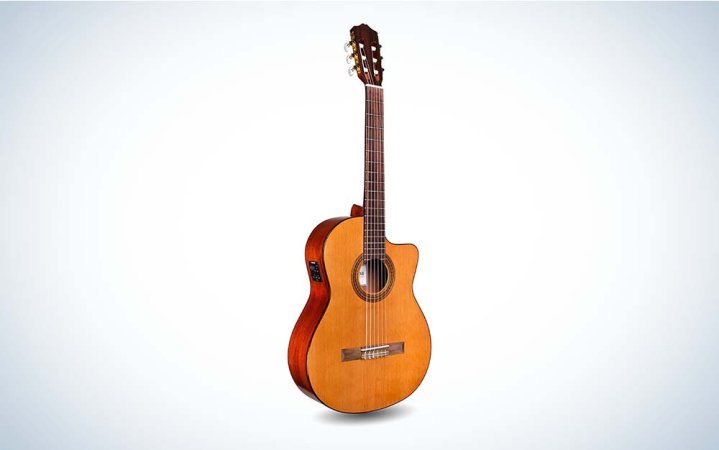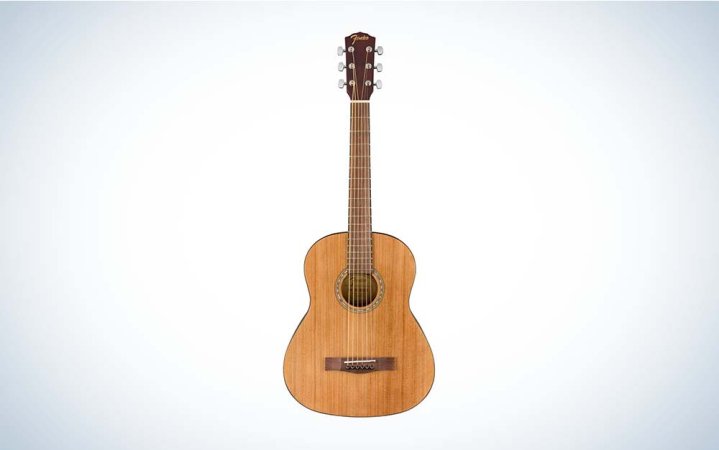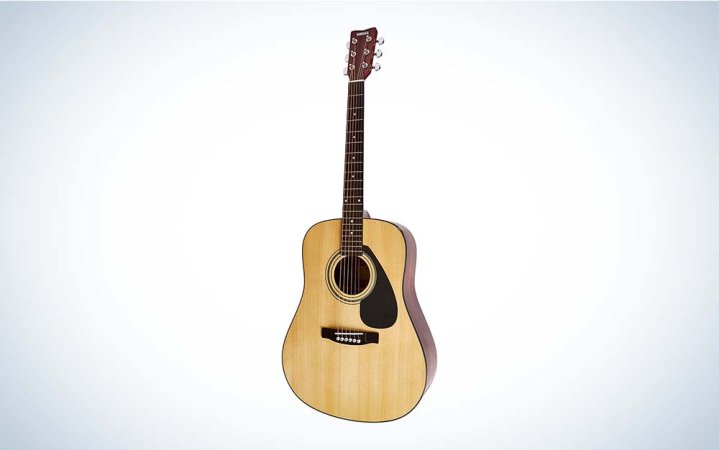We may earn revenue from the products available on this page and participate in affiliate programs. Learn more ›

Acoustic guitars are a timeless staple of popular music styles thanks to their ability to deliver bright, shimmering tones and booming, full-bodied sound projection. Unlike electric guitars, which require separate amplifiers to be heard, the bodies of acoustic guitars feature built-in soundboards and resonant chambers to achieve powerful volume without the need for electricity. This capacity for sound, plus inherent portability and ease of play, makes acoustic guitars one of the most versatile and flexible instruments available, whether you’re playing rock, pop, folk, or country. In this article, we’ll break down some things to consider when choosing between the best acoustic guitars available for players of every level.
- Best thin-body: Yamaha APX600 Acoustic-Electric Guitar
- Best nylon string: Cordoba 6 C5-CE Acoustic-Electric Guitar
- Best for beginners: Fender FA-15N 3/4-Scale Guitar
- Best 3/4 scale: Martin LX1 Little Martin Acoustic Guitar
- Best 12-string: Alvarez AD60 Dreadnought Guitar
- Best budget: Yamaha FD01S Solid Top Acoustic Guitar
How we chose the best acoustic guitars
Acoustic guitars come in various shapes and sizes, and it can be difficult to distinguish one from another based on appearance alone. In compiling this list, I looked at a few key factors that set these acoustic guitars apart from the rest of the pack.
Size and playability: Guitar body size is the most significant factor in determining how compatible the guitar is for a particular player. This list includes 3/4-scale guitars for smaller people and young children, as well as full-scale dreadnought designs to accommodate taller players with longer arms.
Sound and build: Not all guitars are made out of solid wood; in fact, most are constructed using at least one or two varieties of laminate paper products. I selected both solid-top and laminate-top guitars to represent the whole spectrum of available sound varieties. Solid tops offer louder projection but are more fragile than laminate tops, which travel better while offering less sustain and more subdued tones.
Type of strings: The prevailing acoustic guitar sound in popular music today comes from steel-string acoustic guitars, which feature bright, jangly tones. Nylon-string acoustic guitars sound fuller and rounder due to their softer construction. Each type of string has its merits: steel is louder and more prominent, but it’s harder on the fingers; nylon is softer to the touch yet harder to hear in loud settings.
The best acoustic guitars: Reviews & Recommendations
While the prices of professional musical instruments can reach well into the tens of thousands of dollars, you don’t need to spend nearly that much to enjoy lush tones and easy playability. The instruments on this list are priced in a range accessible to most players of every level and benefit from being assembled from new materials using state-of-the-art machinery and equipment. This gives our picks for the best acoustic guitars a great cost-to-value ratio. Just add a tuner and you’re good to go.
Best thin-body: Yamaha APX600 Acoustic-Electric Guitar
Best overall
Yamaha APX6000 Acoustic-Electric Guitar
Pros
- Thinline body is easier to hold than traditional dreadnought designs
- Rich, full sound despite small body
- Built-in 3-band EQ and tuner
Cons
- String action is a bit high out of the box
- No case included
Why it made the cut: The APX600 features a comfortable-to-hold thinline body with a high cutaway, making it one of the easiest-to-play acoustic guitars we’ve tested.
Specs
- Number of frets: 22
- Scale length: 25”
- Materials: Top: Spruce; back and sides: tonewood; neck: nato; fingerboard: rosewood; bridge: rosewood
It’s rare that a thinline acoustic design is able to project sound as well as the Yamaha APX600, an acoustic-electric guitar that strikes a great balance between full-bodied tone and ease of play. In a departure from traditional dreadnought acoustic guitar design, the APX600 measures only 3.5 inches thick, making it lighter to carry and easier to hold close to the body. It also features a high cutaway similar to those found in electric guitar designs, allowing players access to the highest notes on the guitar neck. This makes the APX600 a great option for small players, beginners, or anyone who wants a versatile and portable guitar that doesn’t sacrifice sound quality for size.
The Yamaha APX600 comes with a built-in undersaddle piezo pickup that’s designed for accurate tone reproduction and moderate feedback protection. We love the easy-to-access control panel along the guitar’s top edge, which features a 3-band EQ and built-in tuner system for making quick adjustments anytime. Like most new guitars, the APX600 could benefit from a setup out of the box to lower the string action at its higher frets, but we found it to be very easy to play overall. We also wish it came with a case or gig bag, which would make it easier to transport.
Best nylon string: Cordoba 6 C5-CE Acoustic-Electric Guitar
Best with nylon strings
Cordoba 6 C5-CE Acoustic-Electric Guitar
Pros
- Built-in preamp with tuner and tone controls
- Warm, rich sound
- Soft nylon strings are comfortable to play
Cons
- Traditional wide-fret neck may be large for small hands
- Smooth nylon tone isn’t bright enough for certain music styles
Specs
- Number of frets: 19
- Scale length: 25.6 inches
- Materials: Top: Solid red cedar; back and sides: mahogany; neck: solid mahogany; fingerboard: rosewood; bridge: rosewood
Nylon is the preferred material for classical guitar strings and historical acoustic guitar sounds, providing a softer playing feel and smoother tone than the prevailing steel designs of today. The Cordoba C5-CE is one of the best nylon-string acoustic guitars on the market thanks to a solid cedar wood top that gives it fantastic projection and its unique cutaway design that extends the neck’s playable area far beyond that of standard designs. It also hosts a Fishman pickup and preamp with a two-band equalizer, allowing users to plug directly into amplifier systems and custom-tailor the guitar’s tone without needing a microphone. The C5-CE’s built-in preamp also includes a simple LED tuner display, allowing players to keep perfect guitar pitch at a glance.
As a true classical guitar, the C5-CE has a nut width of 1.96 inches, allowing for ample string spacing and precise left-hand fretting. The downside to this wider neck is that it requires players to have good dexterity to achieve a clean sound without buzzing. If you’re looking for a nylon string acoustic guitar tailored for smaller hands, the Fender FA-15N 3/4-Scale Guitar may be a better choice. Additionally, nylon strings provide a much smoother and darker tone than steel strings, so this guitar may not be the best choice for playing traditionally bright steel-string styles like bluegrass or country rock.
For another option that combines the attributes of an acoustic and electric guitar, check out our review of the Fender Acoustasonic Player Telecaster.
Best for beginners: Fender FA-15N 3/4-Scale Guitar
Best for beginners
Fender FA-15N 3/4 Scale Guitar
Pros
- Nylon strings cause less finger wear than steel
- Three-quarter scale is light and easy to handle
- Includes gig bag for transport
Cons
- Ships with high string action
- Laminate top projects less than solid wood tops
Specs
- Number of frets: 18
- Scale length: 23.3 inches
- Materials: Top: Agathis; back and sides: sapele; neck: nato; fingerboard: walnut; bridge: walnut
Fender’s FA-15 is a scaled-down take on a classic acoustic guitar design that features easy-to-play construction details, making it a good option for new guitar players. Instead of conventional steel strings, it uses nylon strings, which are easier on the hands and allow for easier fretting and holding of notes, especially for new players with softer fingertips. It has an easy-to-hold, 3/4-size body, and its small scale length of 23.3 inches helps beginning players reach across more frets at once. Because hand discomfort is a common problem for first-time guitar players, these design details make the FA-15 a great first guitar choice.
This guitar’s laminate top, combined with its nylon strings, means that it doesn’t project as loudly as a full-size, steel-string guitar, so players of the FA-15 may struggle to be heard when playing music with others. Still, its sapele wood sides and back, combined with the nylon strings, render warm, round tones, especially considering the guitar’s 3/4 scale. The strings are also a bit high off the fretboard out of the box, but this can be fixed by slightly filing down the bridge saddle or the nut.
Best 3/4-scale: Martin LX1 Little Martin Acoustic Guitar
Best 3/4 scale
Martin LX1 Little Martin Acoustic Guitar
Pros
- Miniature design is perfect for travel
- Extensive laminate construction adds durability
- Solid spruce top for loud projection
Cons
- Tone lacks low-end presence of larger designs
- Players with large hands may find it small
Specs
- Number of frets: 20
- Scale length: 23 inches
- Materials: Top: Solid spruce; back and sides: high-pressure laminate; neck: Stratabond wood laminate; fingerboard: Richlite paper composite; bridge: Richlite paper composite
Martin’s LX1 is a miniature guitar made from incredibly strong laminate wood and paper materials, making it a portable and durable choice that’s a great companion instrument for traveling. While guitars made of laminate materials are generally less sought-after than solid wood due to their slightly reduced resonance, the LX1 uses a solid spruce wood top that counteracts some of this effect and allows the guitar to deliver uncharacteristically loud projection for its size. The rest of the LX1’s body—including the back, sides, neck, and bridge—is composed of varying types of high-pressure wood composites that resist cracking, splitting, and denting much better than regular wood.
The LX1 is a travel-friendly guitar scaled down to roughly three-quarters of a standard guitar’s size, so it has a smaller-than-average neck and frets. This makes fretting and playing chords much easier than normal, but users with larger hands may actually find the neck too small to fit their grip comfortably. The LX1’s small body also lacks some of the low-end resonance produced by larger-bodied guitars, so keep that in mind if that’s a sound you’re seeking.
Best 12-string: Alvarez AD60 Dreadnought Guitar
Best overall
Alvarez AD60 Dreadnought Guitar
Pros
- Offset internal bracing allows for louder projection
- Solid spruce top offers high resonance
- Classic body shape produces warm, full, and familiar tones
Cons
- Dreadnought size may be too large for some players
- Slightly high string action out of the box
Specs
- Number of frets: 21
- Scale length: 25.5 inches
- Materials: Top: Solid spruce wood; back and sides: mahogany; neck: mahogany; fingerboard: Indian laurel and rosewood; bridge: Indian laurel and rosewood
The Alvarez AD60 offers classic acoustic guitar tones and remarkable ease of sound projection thanks to its use of solid materials combined with novel construction details. It features a solid Sitka spruce top backed by scalloped internal bracing designed to allow a larger portion of the top to vibrate while playing, resulting in noticeably proud and loud tones and a dynamic range that makes the guitar very responsive and satisfying to play. The guitar’s sides, back, and neck are made of mahogany, a traditionally darker-sounding wood that rounds out the bright tones of the spruce top and results in a well-rounded tone overall.
The AD60 has a dreadnought body, the most prevalent design in the acoustic guitar market thanks to its capacity for volume and resonance. The dreadnought shape is among the largest available, featuring squared shoulders around the neck and a round bottom. While this shape produces a distinct and highly recognizable acoustic guitar tone, its size may feel cumbersome in the hands of players with shorter arms.
Best budget: Yamaha FD01S Solid Top Acoustic Guitar
Best budget
Best budget: Yamaha FD01S Solid Top Acoustic Guitar
Pros
- Solid spruce top is more resonant than laminate
- Rosewood neck for comfort and ease of play
- Full tone and good projection
Cons
- Requires a setup out of the box for optimal performance
- Dreadnought size is large for smaller players
Specs
- Number of frets: 20
- Scale length: 25.25 inches
- Materials: Top: Solid spruce: back and sides: mahogany; neck: nato; fingerboard: rosewood; bridge: rosewood
Yamaha’s FD01S is a dreadnought acoustic guitar made of solid spruce, mahogany, nato, and rosewood, giving it a sound and construction similar to more expensive guitars at a budget price point. Unlike most budget instruments in this price range, which feature laminate tops that are cheaper to produce, it has a solid top that offers pronounced volume and resonance. Combined with its sturdy neck and its soft, easy-to-play fingerboard, the FD01S is one of the best-value acoustic guitars currently available.
Due to its relatively low cost, the FD01S isn’t manufactured with the same attention to detail lavished on more professional instruments. This results in a construction that requires user intervention and a professional setup to achieve the best results. Out of the box, the guitar’s strings are a bit high off of the fretboard and hard to press. Additionally, the FD01S has a standard dreadnought shape that offers bold, resonant tones but may be too large for smaller players to hold.
Things to consider before buying an acoustic guitar
Portability: Acoustic guitars are technically more portable than electric guitars as they can operate without extra amplification equipment, but some acoustic guitars are larger than others. The best acoustic guitars for travel are 3/4-scale designs that take up less space than their full-size counterparts without being so small as to lose the volume and projection for which acoustic guitars are desired.
Size: Dreadnought, or full-size guitars, are often too large for kids and smaller players to hold comfortably against their bodies, and chord fretting on a full-size neck can be a painful stretch for people with smaller hands. Small guitar players will have an easier and more comfortable playing experience with a 3/4-scale acoustic guitar, as those designs have smaller necks and smaller bodies.
Sound: If you’re looking for a bright tone appropriate for rock and pop genres, nothing compares to a standard, steel-string acoustic guitar. Steel strings feature sharp attack and extended high-end frequencies perfect for cutting through recording mixes or projecting in a room filled with other musicians. For soft tones better suited for solo performance, classical music, and some folk music styles, nylon-string designs provide a rounder, warmer, and overall more delicate sound that can be much easier on the ears over extended periods.
FAQs
Strings for electric and acoustic guitars come in various thicknesses and sets. There is no “best” string for acoustic guitar, as some players will prefer the feel of a thin string, while others may prefer a thicker string. For the best all-around performance, a light-tension balanced set like the D’Addario EJ16-3D should offer a sound and feel that please most users.
Because acoustic guitars tend to have slightly thicker strings than electric guitars, they require slightly more force to press down and fret notes without creating a buzzing sound. This, combined with the fact that they don’t typically include pickups to amplify their sound, means that acoustic guitars require slightly more force and effort to produce a clean, clear sound than electric guitars.
Modern classical guitars more resemble the earliest guitar designs than do modern steel-string acoustic guitars, and they’re set apart by a few key design details. The most significant is classical guitars’ use of nylon strings, which are smoother, softer, and warmer-sounding than modern steel-string guitars’ conventionally bright and present sound. It should be noted that classical guitars fall into the category of acoustic guitars, as they’re primarily designed to project sound without electronic pickups and preamps. Therefore, they’re best designated from steel-string acoustics by the specification of their string type.
Final thoughts on the best acoustic guitars
- Best thin-body: Yamaha APX600 Acoustic-Electric Guitar
- Best nylon string: Cordoba 6 C5-CE Acoustic-Electric Guitar
- Best for beginners: Fender FA-15N 3/4-Scale Guitar
- Best 3/4 scale: Martin LX1 Little Martin Acoustic Guitar
- Best 12-string: Alvarez AD60 Dreadnought Guitar
- Best budget: Yamaha FD01S Solid Top Acoustic Guitar
For a classic acoustic guitar sound that’s bright, full, and resonant, look to a dreadnought guitar with a solid spruce top like the Alvarez AD60 Dreadnought Guitar. A 3/4-scale design like the Martin LX1 Little Martin Acoustic Guitar is a better choice for travel use, thanks to its durability and a smaller size that players with small hands may also prefer. Beginning guitarists will enjoy the softer nylon strings of the Fender FA-15N 3/4-Scale Guitar. At the same time, players of every level should consider the Cordoba C5-CE Acoustic-Electric Guitar for a well-rounded and full-bodied electric guitar tone.
